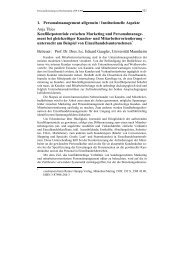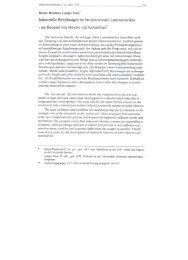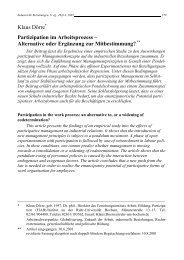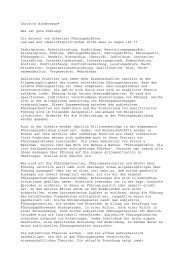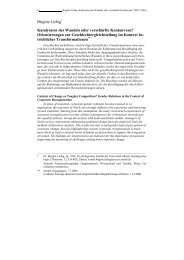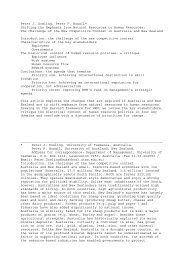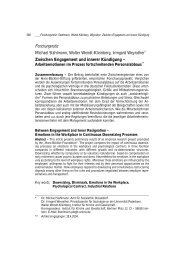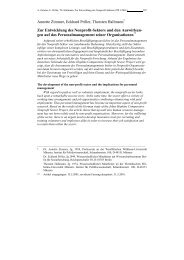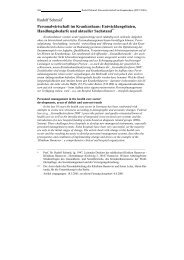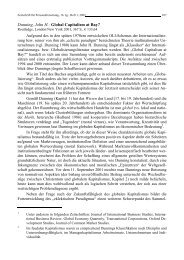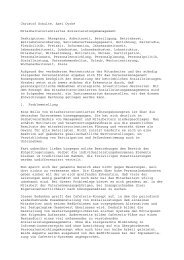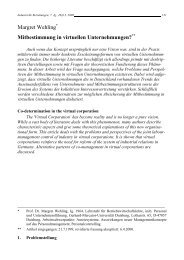Franz Traxler* Employer Associations, Institutions and Economic ...
Franz Traxler* Employer Associations, Institutions and Economic ...
Franz Traxler* Employer Associations, Institutions and Economic ...
You also want an ePaper? Increase the reach of your titles
YUMPU automatically turns print PDFs into web optimized ePapers that Google loves.
42 <strong>Franz</strong> Traxler: <strong>Employer</strong> <strong>Associations</strong>, <strong>Institutions</strong> <strong>and</strong> <strong>Economic</strong> Change<br />
<strong>Franz</strong> Traxler *<br />
<strong>Employer</strong> <strong>Associations</strong>, <strong>Institutions</strong> <strong>and</strong> <strong>Economic</strong> Change:<br />
A Crossnational Comparison **<br />
It is commonly assumed that the current direction of economic change is detrimental<br />
to such collective industrial relations actors as employers’ associations. Adopting a<br />
crossnationally comparative perspective, this paper examines how employers’ associations<br />
cope with this challenge. This is done in two ways. On the one h<strong>and</strong>, the impact<br />
of economic change on membership strength is tested against the impact of industrial<br />
relations institutions that embed collective action. On the other h<strong>and</strong>, the paper analyzes<br />
how the employers’ associations have actively tried to adjust themselves to the<br />
changing conditions.<br />
Arbeitgeberverbände, Institutionen und wirtschaftlicher W<strong>and</strong>el.<br />
Ein internationaler Vergleich<br />
Es ist davon auszugehen, dass der gegenwärtige ökonomische W<strong>and</strong>el die Probleme<br />
kollektiven H<strong>and</strong>elns, wie sie sich Arbeitgeberverbänden stellen, verschärft. Auf der<br />
Grundlage eines internationalen Vergleichs untersucht dieser Aufsatz, wie Arbeitgeberverbände<br />
auf diese Herausforderung reagieren. Dabei werden zum einen die Auswirkungen<br />
des ökonomischen W<strong>and</strong>els im Verhältnis zum Einflussgewicht institutioneller<br />
Faktoren auf die Mitgliederstärke der Arbeitgeberverbände analysiert. Zum <strong>and</strong>eren<br />
wird der Frage nachgegangen, welche Anpassungsstrategien angesichts der veränderten<br />
Rahmenbedingungen von den Arbeitgeberverbänden eingeschlagen werden.<br />
Key words: <strong>Employer</strong>s, employers’ associations, crossnational comparison<br />
___________________________________________________________________<br />
* <strong>Franz</strong> Traxler ist o. Professor für Wirtschaftssoziologie an der Universität Wien, Institut<br />
für Soziologie, Brünner Str. 72, A – 1210 Wien.<br />
E-Mail: <strong>Franz</strong>.Traxler@mailbox.univie.ac.at.<br />
** Artikel eingegangen: 28.2.2003<br />
revidierte Fassung akzeptiert nach doppelt-blindem Begutachtungsverfahren: 8.1.2004.
Industrielle Beziehungen, 11. Jg., Heft 1+2, 2004 43<br />
1. Introduction<br />
A multiplicity of economic developments has brought about significant change in the<br />
context of industrial relations. These developments include technological advances, internationalization<br />
<strong>and</strong> globalization of markets <strong>and</strong> capital, <strong>and</strong> manifold other<br />
changes in production systems, work organization, the sectoral <strong>and</strong> occupational<br />
structure of the economy, <strong>and</strong> macroeconomic policy. It is commonly assumed that<br />
the direction of all these changes is detrimental to the collective actors in industrial relations<br />
(i.e. unions <strong>and</strong> employer associations). This detrimental effect is most evident<br />
in the case of economic internationalization which at the same time represents the<br />
driving force behind most of the other developments mentioned. The dynamics of<br />
economic change have mainly been propelled by the expansion of internationalized<br />
markets which in turn have given rise to intensified competition both within <strong>and</strong><br />
across countries. This poses a serious challenge to collective actors, since market<br />
competition is at odds with the solidaristic principle of collective action: To the extent<br />
that economic change both exp<strong>and</strong>s <strong>and</strong> intensifies market competition, it threatens to<br />
undermine the individual actors’ willingness to associate.<br />
While these processes challenge all collective actors in industrial relations, one<br />
may assume that employer associations are hit more than the unions. This follows<br />
from employers’ special kind of constituency. Companies that are potential members<br />
of employer associations are much more empowered than any other actor in society to<br />
respond to economic change individually <strong>and</strong> autonomously from associational action.<br />
For associations like employer organizations, the integration of their (potential)<br />
membership is a complex phenomenon that relates to several dimensions of compliance,<br />
namely joining the association, paying the fees <strong>and</strong> acting in accordance with the<br />
association’s goals <strong>and</strong> decisions. The economic challenge delineated above most seriously<br />
affects the basic dimension of compliance, that is, membership as such. If it is<br />
true that economic change makes employer associations less important to advancing<br />
employer interests, then the subjectively perceived ratio of costs <strong>and</strong> benefits regarding<br />
membership tends to deteriorate. Affiliated employers are likely to leave <strong>and</strong> newly<br />
established companies will probably not join.<br />
This paper examines how the employer associations cope with this challenge.<br />
This analysis is based on a comparison of 20 OECD countries (Table 1). First of all,<br />
this requires analyzing the development of their membership strength <strong>and</strong> the determinants<br />
of this development. Hence, the paper’s following section elaborates the hypotheses<br />
<strong>and</strong> measures for this analysis. After this, the data <strong>and</strong> findings are presented.<br />
For a full underst<strong>and</strong>ing of the development of employer associations, we also need to<br />
know whether <strong>and</strong> how they have tried to adjust themselves to the changing economic<br />
conditions. This is the issue of the next section. 1 The paper concludes by discussing<br />
the implications these findings have for the future of employer associations.<br />
1 Put in epistemological terms, the (quantitative) analysis of membership deals with the<br />
„causes“ of the observed development of employer associations, whereas the (qualitative)<br />
study of their adjustment strategies addresses the „reasons“ for this development.
44 <strong>Franz</strong> Traxler: <strong>Employer</strong> <strong>Associations</strong>, <strong>Institutions</strong> <strong>and</strong> <strong>Economic</strong> Change<br />
2. Hypotheses <strong>and</strong> measures<br />
First of all, we have to operationalize the dependent variable: employer associations<br />
<strong>and</strong> their membership strength. <strong>Employer</strong> organizations are understood as associations<br />
aimed at representing labour market interests, in contrast to interests which<br />
business has in other markets. This definition includes „pure” employer associations<br />
(specialized exclusively in labour market interests) <strong>and</strong> „mixed” associations (organizing<br />
both labour market interests <strong>and</strong> other business interests). Membership strength is<br />
measured as associational density (i.e. the ratio of actual to potential members). There<br />
are two measures of employer density, referring to either the firms themselves or the<br />
firms’ employees (Traxler et al. 2001). The power of an employer association as compared<br />
to its union counterparts depends less on the number of firms than on the<br />
number of employees covered. Hence, measuring employer density in terms of employees<br />
is preferable.<br />
Data on employer density are sparse. At the same time, employer associations are<br />
numerous. Even in the case of small countries like Portugal <strong>and</strong> the Netherl<strong>and</strong>s estimates<br />
suggest that several hundred exist. For this reason, our analysis of density is<br />
confined to a country’s principal (i.e. largest) employer peak organization whose formal<br />
membership domain is country-wide <strong>and</strong> cross-sectoral. Peak organizations are<br />
independent in that they are not subordinate to any other employer association. <strong>Employer</strong><br />
density (LED) is defined as the proportion of employees organized by the largest<br />
employer peak within its own domain, understood as formal eligibility for membership<br />
laid down in the peak’s constitution. In line with this operationalization, all of<br />
the above associational measures but interassociational fragmentation (ESYS) refer to<br />
the principal employer peak. 2<br />
In line with the general argument outlined above, the ongoing direction of economic<br />
change is expected to erode member support. Accordingly, the quantitative<br />
analysis should show a statistically negative impact of economic change on density.<br />
However, there is an alternative hypothesis, emphasizing the relevance of (nonmarket)<br />
institutions that embed associational action. The argument is that institutions<br />
can defy competitive pressures due to market imperfections (North 1990). This means<br />
that associations may be able to maintain member support despite unfavourable economic<br />
conditions, when being backed by strong institutions that enable them to overcome<br />
their collective action problems (Traxler et al. 2001). This implies that the level<br />
<strong>and</strong> the development of employer density should significantly vary with institutional<br />
configurations. We will thus test a convergence thesis (predicting a general decline in<br />
member support across countries as a result of economic change) against a pathdependency<br />
thesis (assuming continued diversity of density due to differing institutions).<br />
In contrast to numerous studies of union density, comparable analysis of employer<br />
density is rare. The following specification of hypotheses thus draws from collective<br />
action theory (Olson 1965), from findings on union density (as far as they are<br />
applicable to employers) <strong>and</strong> in particular from recent comparative research in employer<br />
associations (Traxler 2000a; Traxler et al. 2001; Traxler 2003). When revisiting<br />
2 For a detailed operationalization of all measures, see the Appendix.
Industrielle Beziehungen, 11. Jg., Heft 1+2, 2004 45<br />
this literature, one finds two clusters of possible determinants of employer density that<br />
correspond with the two competing main theses outlined above.<br />
The first cluster addresses the economic context of associational action. As mentioned<br />
above with regard to economic change, this context embraces a multiplicity of<br />
distinct dimensions. Their impact on density varies with the respective interest group.<br />
For instance, work organization <strong>and</strong> the occupational structure of the economy are<br />
negligible in the case of employer associations, whereas they certainly affect the membership<br />
strength of the unions. We thus focus on those dimensions which are hypothesized<br />
to be most important to employer associations: that is, economic internationalization,<br />
the sectoral composition of the economy <strong>and</strong> the size of the economy.<br />
One may argue that economic internationalization challenges employer associations<br />
even more than unions. Paradoxically at first glance, this is because economic internationalization<br />
creates opportunities rather than threats for the companies as a distinct<br />
class of actors in comparison to other categories of industrial relations actors.<br />
The reason for this is that internationalization of markets enhances the possibilities of<br />
cross-border mobility on the one h<strong>and</strong>, <strong>and</strong> that companies are superior to any other<br />
actor in terms of their capacity for cross-border mobility on the other h<strong>and</strong>. This<br />
growing capacity of the companies for cross-border mobility <strong>and</strong> their transnational<br />
presence in markets threaten to devaluate the benefits of associations whose domain is<br />
always limited in territorial respects. Moreover, growing possibilities of cross-border<br />
mobility tend to fuel the employers’ worldwide attempts to decentralize <strong>and</strong>/or deregulate<br />
industrial relations <strong>and</strong> to re-integrate them into the realm of their company.<br />
Since these tendencies question the role of employer organizations in industrial relations,<br />
their relevance for business may become increasingly dubious. Hence, the hypothesis<br />
is that economic internationalization significantly damages employer density.<br />
Internationalization primarily takes place in product markets <strong>and</strong> financial markets.<br />
The st<strong>and</strong>ard indicator of a country’s internationalization of product markets is foreign<br />
trade dependence, defined as the sum of exports <strong>and</strong> imports as a percentage of<br />
GDP (OPEN1). To measure financial internationalization, we use foreign direct investment<br />
(FDI), understood as inward plus outward investment as a percentage of<br />
GDP.<br />
The sectoral composition of the economy may affect employer associations in a<br />
way analogous to the unions (Visser 1991): manufacturing is likely to be the stronghold<br />
of employer associations, as compared to the service sector. Hence, there should<br />
be a positive relationship between the size of the manufacturing sector <strong>and</strong> density.<br />
Since there has been a long-term trend towards an expansion of the service sector<br />
relative to manufacturing across the OECD, this kind of economic change should also<br />
work to the disadvantage of employer associations. The size of manufacturing<br />
(MAN1) is measured as the share of the sector’s employees in the total number of a<br />
country’s employees.<br />
Aside from its sectoral composition, the sheer size of an economy is likely to influence<br />
density. Growing group size affects collective action negatively (Olson 1965).<br />
From the associations’ perspective, the strategy of maximizing membership may be<br />
less rational in large countries than in small ones (Wallerstein 1989), since a reasonably<br />
high number of members is sufficient for resourcing an association. In large countries,
46 <strong>Franz</strong> Traxler: <strong>Employer</strong> <strong>Associations</strong>, <strong>Institutions</strong> <strong>and</strong> <strong>Economic</strong> Change<br />
this (absolute) number of members can be reached at lower density levels, compared<br />
to small countries. Since associations are normally forced to economize on resources,<br />
it is not rational for them to invest in increasingly expensive member recruitment beyond<br />
that absolute number of members required for effective action. Our measure of<br />
the size of the economy (DEP1) is the total number of a country’s employees.<br />
The second cluster of factors refers to the employers’ institutional context. As regards<br />
those institutions which can contribute to solving the recruitment problems of<br />
employer associations, two categories of institutions are of utmost importance: the organizational<br />
structure of employer associations <strong>and</strong> mechanisms providing selective<br />
incentives for their members.<br />
<strong>Employer</strong> associations can attract potential members by tailoring their organizational<br />
structures as closely to their members’ immediate interests as possible. This involves<br />
an association’s demarcation of domain <strong>and</strong> its decision-making procedures.<br />
The demarcation of domain defines the range of interests covered by an association.<br />
Encompassing domains induce associations to internalize highly heterogeneous interests.<br />
Under these conditions the interests of a certain member group will often be neglected<br />
<strong>and</strong> filtered out in the course of internal interest aggregation <strong>and</strong> goal formation.<br />
Hence, encompassing domains create more problems for member recruitment<br />
than narrow domains do. Our measure of the scope of domains (i.e. the concentration/fragmentation<br />
of the associational system) is the number of national, crosssectoral<br />
employer associations (ESYS): The larger the number of associations, the narrower<br />
their interest domain tends to be, because associations are forced to specialize<br />
in certain interests under these circumstances. Internal decision-making procedures<br />
are also important to member recruitment. An individual employer’s influence on the<br />
decision-making process decreases with growing centralization. This probably deters<br />
employers from joining an association. When measuring centralization, we focus on<br />
the employers’ rights <strong>and</strong> obligations in relation to higher hierarchical levels of goal<br />
formation (ECENF). The hypothesis is that employer density increases with interassociational<br />
fragmentation (i.e. narrowly defined interest domains, indicated by a large<br />
number of associations) <strong>and</strong> with intra-associational decentralization.<br />
Selective incentives reward members <strong>and</strong>/or punish non-members. In principle,<br />
any associational service offered exclusively to members can work as a selective incentive.<br />
In practise however, services may also be collective goods (from which also nonmembers<br />
benefit) or a mixture of selective <strong>and</strong> collective goods. An example is the associational<br />
representation of members in labour court proceedings. The representation<br />
of the particular member involved is certainly a selective good. However, a basic<br />
ruling by the court in favour of the employer is also a collective good. To identify an<br />
association’s selective incentives, in-depth analysis of each single activity would be<br />
needed, something which is beyond a comparison of 20 countries. Instead, we take<br />
the range of an association’s representational activities vis-à-vis the state (EAP) as a<br />
yardstick for its service potential. The rationale of this measure is that an association<br />
can derive selective incentives from the provision of collective goods. For instance, an<br />
association’s participation in industrial policy may serve as the basis for faster <strong>and</strong> better<br />
informing the members about related issues. Therefore, we expect density to in-
Industrielle Beziehungen, 11. Jg., Heft 1+2, 2004 47<br />
crease with the range of state-related representational activities performed by the association.<br />
<strong>Employer</strong> associations can also derive selective incentives from bargaining with<br />
the unions. Strong unions induce the employers to associate because protection<br />
against labour’s collective action is a key function of employer associations. Incentives<br />
of this kind include such activities as advice on matters of industrial relations <strong>and</strong> financial<br />
support in case of industrial disputes which employer associations will provide<br />
only for member companies. More generally, employer associations are designed to<br />
counter „whipsawing“ union tactics aimed at confronting each company individually. 3<br />
Put in operational terms, employer density is assumed to grow with union density<br />
(UD1).<br />
Another selective incentive results from statutory provisions for extending multiemployer<br />
collective agreements to those employers not affiliated to the signatory employer<br />
association (Gladstone 1984; Traxler 1998a). Given such practices, employers<br />
have good reason to believe that a collective agreement will bind them even when they<br />
stay outside the association. Hence, it is rational for them to associate so as to be entitled<br />
to participate in the bargaining process the outcome of which may be binding on<br />
them in any case. We thus hypothesize that employer density increases with the pervasiveness<br />
of extension (EXTP).<br />
3. Data <strong>and</strong> findings<br />
As a consequence of the limited availability of comparable time series data on employer<br />
density, it is impossible to employ a pooled time-series design. Instead, this<br />
analysis adopts a cross-sectional approach, which compares two periods (i.e. 1986-<br />
1990 <strong>and</strong> 1994-1996). For reasons of space, descriptive statistics are presented here<br />
only for the dependent variable, that is, density (Table 1).<br />
With 100 %, density is highest in Austria, since all firms in the WKÖ’s domain<br />
are legally required to be members. The WKÖ is the only principal employer peak relying<br />
on obligatory membership. However, formally voluntary membership co-exists<br />
with informal mechanisms of compulsory member recruitment in several other countries.<br />
Most importantly, compulsory payment of dues, which comes closest to compulsory<br />
membership, is institutionalized on the basis of sectoral-level collective bargaining<br />
in Belgium, the Netherl<strong>and</strong>s <strong>and</strong> Spain. For example, in Belgium’s textile industry,<br />
all employers are obliged to pay 1% of gross wages to a central fund primarily<br />
designed to finance payment of additional unemployment benefits to union members.<br />
This fund also sponsors the sector’s employer association, which keeps 5% of all contributions<br />
for running its own organization (Blanpain 1998: 282). Under these circumstances,<br />
the employer associations – in cooperation with their union counterparts –<br />
are able to impose levies on non-members via legally based extension of collective<br />
3 Notably, the power of these incentives tends to vary with employer groups, namely with<br />
firm size. This is not only because union density increases with firm size (Visser 1991). In<br />
addition, confronting each single firm probably overstretches even the power of strong<br />
unions, such that they will concentrate their whipsawing tactics on large companies.
48 <strong>Franz</strong> Traxler: <strong>Employer</strong> <strong>Associations</strong>, <strong>Institutions</strong> <strong>and</strong> <strong>Economic</strong> Change<br />
agreements to unaffiliated firms. Given the obligatory payment of dues, employers<br />
have every reason to join their association.<br />
Table 1: The largest employer peak organization: density (LED)<br />
Country Name LED*<br />
1986-90 1994-96<br />
A WKÖ 100 100<br />
AUS CAI (1986–95), ACCI 62 75 g<br />
B VBO/FEB 72<br />
CDN –– 0 0<br />
CH ZSAO, SAV c 39 37<br />
D BDA 73 h 72 h<br />
DK DA 38 39<br />
E a CEOE 75 72<br />
F CNPF d 75 74<br />
FIN STK (1986–93), TT 42 44<br />
UK CBI 54<br />
I C 81 39<br />
IRL FUE, FIE e (1986–93), IBEC 36 39<br />
JP Nikkeiren 39 40 g<br />
N NAF, NHO f 32 31<br />
NL VNO (1986–94), VNO-NCW 79<br />
NZ NZEF 90 90<br />
P b CIP 34<br />
S SAF 54 55<br />
USA –– 0 0<br />
Mean 52.3 52.3<br />
* Period means or most recent data<br />
a Since 1977, b Since 1975, c ZSAO renamed in SAV in 1996, d CNPF renamed in MEDEF<br />
in 1998,<br />
e FUE renamed in FIE in 1989, f NAF renamed in NHO in 1990, g 1997, h West Germany.<br />
For definition of LED <strong>and</strong> abbreviations, see Appendix.<br />
Data basis: Traxler et al. (2001).
Industrielle Beziehungen, 11. Jg., Heft 1+2, 2004 49<br />
Aside from Austria, the peaks of Australia, New Zeal<strong>and</strong>, (West)Germany, France,<br />
Belgium, the Netherl<strong>and</strong>s, <strong>and</strong> Spain record high density levels of more than 70%.<br />
Until the 1990s, Italy’s Confindustria also belonged to this group. The subsequent decline<br />
in density results from an extension of its domain since 1991 from manufacturing<br />
to services, where the level of membership lags behind that of manufacturing.<br />
<strong>Employer</strong> density is not outst<strong>and</strong>ing in the Nordic countries. Two factors (as the following<br />
analysis will show) mainly account for this situation: extension practices do not<br />
exist in these countries except Finl<strong>and</strong>. Furthermore, all Nordic peaks are characterized<br />
by extremely high centralization that makes them strong in terms of strategic capacity<br />
but negatively affects their membership strength. In Australia, the strong increase<br />
in density from the early to the mid-1990s reflects the merger of the CAI <strong>and</strong><br />
the Australian Chamber of Commerce to form the ACCI.<br />
Finally, the USA <strong>and</strong> Canada lack any form of employer peak associations. Below<br />
peak level, Canada records employer associations in a few sectors which differ considerably<br />
in their role across the distinct provincial jurisdictions.<br />
The comparison of the two periods suggests high stability of employer density.<br />
With the exception of Italy <strong>and</strong> Australia, only slight changes took place, without particular<br />
trend.<br />
Turning now to the empirical examination of our hypotheses, we will leave out<br />
the case of Austria, since its principal peak relies on obligatory membership. To address<br />
each single hypothesis, we begin with a cross-sectional design, based on bivariate<br />
correlations (Table 2).<br />
Table 2: <strong>Economic</strong> <strong>and</strong> institutional correlates of employer density (LED)<br />
1986-90 n 1994-96 n<br />
FDI 0.22 15 0.31 17<br />
OPEN1 -0.05 15 0.12 19<br />
MAN1 0.52 15 0.06 19<br />
LNDEP1 -0.15 15 -0.23 19<br />
EAP -0.21 13 -0.26 17<br />
ECENF -0.28 13 -0.47 17<br />
ESYS 0.41 13 0.12 17<br />
EXTP 0.59 15 0.44 19<br />
UD1 -0.01 15 -0.10 19<br />
Pearson's correlation; n = number of cases<br />
For the countries included, see Table 1; Austria generally omitted; Canada <strong>and</strong> the USA<br />
excluded with regard to EAP, ECENF <strong>and</strong> ESYS; Belgium <strong>and</strong> Portugal excluded with<br />
regard to FDI (1994-96).<br />
For definition of the institutional variables, see Appendix.<br />
Most essentially, none of the two measures of economic internationalization has the<br />
expected relationship with density (LED). Foreign trade dependence (OPEN) is almost<br />
completely irrelevant. Foreign direct investment (FDI) affects density. However,<br />
this contrasts with the hypothesis in that density tends to increase with FDI. This suggests<br />
that the transnational spread of market relations by economic internationaliza-
50 <strong>Franz</strong> Traxler: <strong>Employer</strong> <strong>Associations</strong>, <strong>Institutions</strong> <strong>and</strong> <strong>Economic</strong> Change<br />
tion does not undermine employer solidarity as demarcated by national boundaries.<br />
The effect of manufacturing (MAN1) is difficult to assess. This is because the two<br />
subperiods available strongly differ in the number of countries which is paralleled by<br />
differences in how the domains of the national peak associations relate to manufacturing.<br />
We shall return to this issue when presenting the results of the multivariate analysis.<br />
Among the factors related to the economic context of associational action, only<br />
the size of the economy (LNDEP1) shows a clear effect in line with the above assumptions.<br />
Institutional factors (especially extension practices) are much more important<br />
than the economic context. All institutional factors except two are correlated with<br />
density in the hypothesized way. 4 The two exceptions are associational participation in<br />
public policy (EAP) <strong>and</strong> union density (UD1). There is even a negative relationship of<br />
associational participation with density (LED). This indicates that associational participation<br />
works primarily as a collective good from which selective incentives cannot<br />
systematically be extracted. The case of union density is more complex. Its (statistical)<br />
irrelevance is caused by such intervening variables as external, state-provided membership<br />
incentives. Such incentives are essential to both employees <strong>and</strong> employers. The<br />
two sides of industry, however, differ in what external selective incentives matter: in<br />
the case of employees, the decisive incentives are union-led unemployment schemes<br />
(Ebbinghaus/Visser 1999; Traxler et al. 2001); for employers, the extension of collective<br />
agreements matters. What makes the density of employers <strong>and</strong> employees rather<br />
independent of one another is the fact that any establishment of these two types of incentives<br />
does not co-vary across countries. For instance, in most of the Sc<strong>and</strong>inavian<br />
countries, union-led unemployment schemes exist but extension practice is completely<br />
lacking. This contributes to the clearly higher level of union density there, compared<br />
to the employers. The diametrically opposed pattern characterizes countries like<br />
France, Portugal, <strong>and</strong> Spain, where extension is pervasive <strong>and</strong> union-led unemployment<br />
schemes do not exist at all. In all these cases, employer density surpasses union<br />
density. Another intervening factor is product-market interests. When employer associations<br />
are mixed, businesses may join for the mere reason of product-market interests,<br />
implying that unions are no incentive for employers to associate. This is examplified<br />
by the CBI. It has largely retained its density although industrial relations activities<br />
have receded into the background. In contrast, Britain’s lower-level employer associations<br />
lost around half of their density (in terms of establishments) over the 1980s<br />
(Millward et al. 1992), when multi-employer bargaining withered away. Hence, the<br />
CBI’s ability to attract members primarily comes from its role as a trade association<br />
that deals with product-market interests.<br />
One can infer from this that union density affects employer density most strongly<br />
in those countries where pure employer associations are established <strong>and</strong> where neither<br />
union-led unemployment schemes nor extension practice exist as the two key selective<br />
incentives for employees <strong>and</strong> employers. Testing this hypothesis encounters serious<br />
4 To investigate the effect of centralization <strong>and</strong> associational participation on density, the<br />
USA <strong>and</strong> Canada must be left out, since there can be no effect caused by organizational<br />
structures, if employer associations do not exist.
Industrielle Beziehungen, 11. Jg., Heft 1+2, 2004 51<br />
problems. Above all, it is impossible to differentiate between mixed <strong>and</strong> pure employer<br />
peaks, because many affiliates – even of pure employer peaks – are mixed.<br />
Hence, we must exclude the functional differentiation of employer associations from<br />
our considerations. We can control only for selective incentives: there are seven countries<br />
where neither union-led unemployment schemes nor extension provisions are in<br />
operation (Irel<strong>and</strong>, Italy, Norway, the UK, Japan, Canada, <strong>and</strong> the USA). In line with<br />
our basic assumption, employer density is positively correlated with union density in<br />
the case of this subgroup of countries (r LED/UD1 = 0.34 [n = 7, 1994–1996]).<br />
To take account of this complex interplay of factors for the purpose of the multivariate<br />
analysis, we include the interaction of extension practices (which thus will be<br />
introduced as a dichotomized dummy variable, EXTPD) with union density<br />
(EXTPDxUD1). Taking into consideration that centralization (ECENF) <strong>and</strong> associational<br />
fragmentation (ESYS) have no meaningful score in the case of the USA <strong>and</strong><br />
Canada, the mean for this variable was assigned to these countries. A dummy for the<br />
special case of New Zeal<strong>and</strong> is also included in the model referring to the second period<br />
under examination (i.e. 1994–1996). This is because of the lagged consequences<br />
of the 1993 reform of the industrial relations system. Until 1996 this reform led to notable<br />
changes, namely a decline in union density, the shift from multi- to singleemployer<br />
bargaining <strong>and</strong> the concomitant disappearance of extension practice. However,<br />
employer density which should decline in response to these changes according to<br />
our hypotheses, actually fell to a considerable extent only after the end of the focused<br />
period. In addition to the institutional factors noted above, manufacturing (MAN1)<br />
enters the model, since this it the only variable of economic change for which the<br />
bivariate analysis (Table 2) has at least shown the expected direction of influence. 5 Table<br />
3 presents the findings of the multivariate analysis for both reference periods.<br />
There is the expected, significant effect of this variable for the first period. The<br />
same holds true for associational fragmentation (ESYS). All the other institutional<br />
variables show a significant impact on employer density over both periods in accordance<br />
with the hypotheses: Growing intra-associational centralization of decisionmaking<br />
significantly dampens the density ratio of employer associations. Furthermore,<br />
employer density is significantly higher in a situation of extension practices<br />
(EXTPD + ), as compared to countries where such practices are absent. <strong>Employer</strong> density<br />
also significantly increases with union density (UD1 + ) in the case of absent extension<br />
practices. The negative coefficient of the interactive term (EXTPDxUD1) indicates<br />
that union density even shows a strong negative association with employer density,<br />
if extension provisions are implemented. This means that extension provisions<br />
(when practiced) clearly dominate <strong>and</strong> overshadow union density as a determinant of<br />
employer density.<br />
5 We exclude the other variables of economic change from the multivariate analysis not<br />
only because their bivariate correlations with employer density showed no consistend effect.<br />
In addition, one should not inflate the number of independent variables in a smallsample<br />
situation.
52 <strong>Franz</strong> Traxler: <strong>Employer</strong> <strong>Associations</strong>, <strong>Institutions</strong> <strong>and</strong> <strong>Economic</strong> Change<br />
Table 3: The determinants of the level of employer density (LED)<br />
MAN1<br />
1.93**<br />
[2.63]<br />
ECENF<br />
-9.66***<br />
[-3.24]<br />
ESYS<br />
5.73***<br />
[3.77]<br />
EXTPD + 69.51***<br />
[4.45]<br />
UD1 + 1.97***<br />
[3.92]<br />
EXTPDxUD1<br />
-1.03**<br />
[-3.08]<br />
NZ<br />
---<br />
---<br />
Constant<br />
-152.05***<br />
[-4.86]<br />
1986-90 1994-96<br />
0.55<br />
[0.57]<br />
-10.28**<br />
[-2.81]<br />
2.64<br />
[1.27]<br />
72.82***<br />
[4.35]<br />
1.82***<br />
[3.10]<br />
-1.01**<br />
[-2.69]<br />
37.31*<br />
[2.09]<br />
-117.40**<br />
[-2.92]<br />
R 2 0.76 0.55<br />
N 15 19<br />
F-Test 0.01 0.02<br />
Durbin-Watson statistic 1.49 1.85<br />
* p 0.10; ** p 0.05; *** p 0.01; R 2 = adjusted coefficient of determination<br />
Entries are OLS-coefficients in period-specific cross-section models; t-statistics in square<br />
brackets.<br />
EXTPD + : extension practiced (absent extension is the reference category).<br />
UD1 + : union density if extension is absent.<br />
EXTPDxUD1: interactive effect, indicating the differential impact of UD1, conditional<br />
on whether extension is practiced or not.<br />
USA <strong>and</strong> CDN: values for ESYS <strong>and</strong> ECENF set to overall mean; Austria omitted; NZ:<br />
control for the special case of New Zeal<strong>and</strong> (1994–96).<br />
For variable definitions, see Appendix.<br />
The upshot of these findings is that employer density is predominantly shaped by its<br />
institutional context. Above all, the strong impact of extension practices (EXTPD)<br />
<strong>and</strong> union density (UD1) underpins the relevance of engagement of employer organizations<br />
in labour relations in general <strong>and</strong> collective bargaining in particular. Put more<br />
succinctly, it is multi-employer bargaining which is central to the membership strength<br />
of employer associations, since extension provisions can be implemented only in connection<br />
with multi-employer settlements.<br />
All in all, this analysis confirms other comparative studies of employer density<br />
which, however, differ in the set-up of the multivariate model <strong>and</strong> the measures of the<br />
institutional variables (Traxler et al. 2001, Traxler 2003). This suggests a high robustness<br />
of findings.
Industrielle Beziehungen, 11. Jg., Heft 1+2, 2004 53<br />
4. The associational responses to the challenge of economic change<br />
The above analysis has shown that employer density is strongly influenced by institutional<br />
factors, whereas the effect of economic conditions is rather negligible. Although<br />
we lack long-term data series on employer density, this finding suggests that economic<br />
change has not resulted in a membership crisis of employer associations. This, however,<br />
does not mean that there is not any effect of economic developments at all.<br />
Rather, the given institutions (including the employer associations themselves) have<br />
mediated these effects, implying that the magnitude of challenge, as posed by economic<br />
change, varies with institutional configurations. 6 This section gives an overview<br />
of what adjustment strategies the employer associations have adopted in order to offset<br />
the potentially detrimental effects of economic change on their level of membership.<br />
As noted above, the essence of these detrimental effects is that economic change<br />
has qualified the benefits of associational membership in relation to its costs. Generally,<br />
this loss in benefits has been caused by the fact that the above economic developments<br />
have given rise to more or less accentuated tendencies towards decentralization<br />
<strong>and</strong> deregulation of industrial relations across the OECD. These processes of decentralization<br />
<strong>and</strong> deregulation have in turn resulted in growing importance of the<br />
companies as compared to employer associations, when it comes to regulating the<br />
terms of employment. In principle, employer associations have had two basic options<br />
of coping with this challenge. First, they can offset this loss of benefits by mobilizing<br />
new incentives for membership. This option means functional adjustments to economic<br />
change. Second, employer associations can compensate for the loss in benefits by<br />
lowering the costs of membership, such that the ratio of costs <strong>and</strong> benefits does not<br />
alter significantly. This option relies on structural adjustments to economic change.<br />
Empirical evidence suggests that employer associations have resorted to both options,<br />
all the more since they represent complementary rather than alternative approaches.<br />
As far as functional adjustments are concerned, one notable strategy pursued by<br />
national peak associations has been to replace tasks directly related to collective bargaining<br />
with functions of political lobbying. Comparative research in the development<br />
of collective bargaining has shown that in most countries decentralization of bargaining<br />
has taken the form of a decay of central-level, interindustry bargaining (in favour<br />
of combined bargaining at sector <strong>and</strong> company level) rather than a radical move from<br />
multi- to single-employer bargaining (Traxler et al. 2001). As a consequence, bargaining<br />
decentralization has most strongly questioned the role of the peak-level employer<br />
associations. In line with their all-encompassing, cross-sectoral domain, peak-level associations<br />
are designed to aggregate <strong>and</strong> represent the interests common to all groups<br />
of employers. In a context of central-level bargaining being in decline, it is rational for<br />
6 The recent crisis of the German employer associations (e.g. Artus 2001; Schroeder/Ruppert<br />
1996; Völkl 2002) fits well into this path-dependent mode of development.<br />
As union density has strongly declined as well as extension practices have always been<br />
limited <strong>and</strong> have even decreased since the mid-1990s, Germany meets key preconditions<br />
for a decline in membership of employer associations, seen from a comparative perspective<br />
(see Tables 2 <strong>and</strong> 3).
54 <strong>Franz</strong> Traxler: <strong>Employer</strong> <strong>Associations</strong>, <strong>Institutions</strong> <strong>and</strong> <strong>Economic</strong> Change<br />
the national peak employer associations to re-orient their profile from bargaining issues<br />
to tasks of political lobbying <strong>and</strong> campaigning that address the government <strong>and</strong><br />
the public. An example of a profound re-orientation of this kind is Sweden’s SAF<br />
which withdrew from centralized bargaining in the early 1990s , while political opinion<br />
formation has strongly gained in importance (Pestoff 1995). Likewise, its French<br />
counterpart, CNPF, has underscored its shift in priorities from central-level bargaining<br />
to the political promotion of business interests by renaming itself in Mouvement des<br />
Entreprises de France (MEDEF) in 1998 (EIRO 1998).<br />
According to the categorization by Olson (1965), replacing collective bargaining<br />
tasks by lobbying activities is a case of functional adjustment that substitutes one certain<br />
collective good for another one. As peak associations not always interact directly<br />
with the company members covered under their umbrella, they have limited opportunity<br />
to resort to the classical means of improving the benefits of associational membership:<br />
that is, the provision of selective incentives. For the above reasons, any systematic<br />
inquiry into the range <strong>and</strong> change in selective incentives offered by employer<br />
associations is beyond this study. We thus lack comparative information about the extent<br />
to which employer associations have responded to the challenges of economic<br />
change by extending the range of selective incentives. Regardless of this, this has<br />
probably not happened on a large scale. This is because offering more selective incentives<br />
requires additional resources, something which conflicts with the very strong<br />
pressures to cut costs (see below). However, the example of New Zeal<strong>and</strong> underpins<br />
that this strategy can be essential under certain circumstances (Traxler et al. 2001). The<br />
1991 deregulation of industrial relations has resulted in a significant move from multiemployer<br />
bargaining to single-employer bargaining which forced the employer associations<br />
to undergo radical reforms as well. As the case study of the Auckl<strong>and</strong> <strong>Employer</strong>s<br />
Association demonstrates (Carrol/Tremewan 1993), employer organizations have<br />
done so by deliberate commercialization. While the association lost its bargaining<br />
tasks, it developed into a professional provider of services which are sold to members.<br />
Meanwhile, earnings from services exceed general membership fees which were reduced<br />
in the course of the reform. The case also illustrates that - under the given financial<br />
constraints imposed on employer associations – the expansion of <strong>and</strong> the improvement<br />
in services is bound to making them payable. This in turn tends to convert<br />
the association from a genuine employer organization into a commercialized undertaking.<br />
Such a strategy is feasible in response to a radical change in the industrial relations<br />
system, as happened in New Zeal<strong>and</strong>. Another, more important strategy of functional<br />
adjustment has been to place more or new emphasis on representation of product<br />
market interests. In the case of pure employer associations this has often taken the<br />
form of mergers with trade associations specialized in product market interests.<br />
Among the 20 countries, Irel<strong>and</strong>, Norway, Portugal <strong>and</strong>, more recently, Sweden <strong>and</strong><br />
Japan saw a shift of their principal employer peak association from the pure to the<br />
mixed status. One can observe analogous developments below peak level in several<br />
countries (e.g. Sweden).<br />
Mergers are aimed not only at functional adjustments in the sense of incorporating<br />
product market interests. Aside from this, they may also relate to structural adjustments,<br />
designed to curb costs <strong>and</strong> economize on resources. At peak level, such
Industrielle Beziehungen, 11. Jg., Heft 1+2, 2004 55<br />
merger happened in Finl<strong>and</strong>, where the mixed employer peak, STK, combined with a<br />
trade peak association to form TT in 1993. In particular, structural adjustments by<br />
mergers involve the associations below peak level, since most synergy effects can be<br />
created when narrow associations combine to form more encompassing units. However,<br />
as the crossnational comparison reveals, it is not a strategy frequently used. For<br />
13 of the 20 OECD countries, data on the number of affiliates to the principal employer<br />
peak association are available. The fact that the average number of affiliates per<br />
peak association only slightly decreased from 86.5 in 1980 to 85.4 in 1996 indicates a<br />
very limited tendency to merge (Traxler et al. 2001). One explanation for this lies in<br />
the above finding that companies prefer narrow associations over more encompassing<br />
ones. In addition, the need to form special associations for newly emerging sectors has<br />
more or less offset the limited number of mergers. It should be noted, however, that<br />
the effectiveness of structural adjustments by mergers varies widely across countries.<br />
They are most thoroughgoing in the Sc<strong>and</strong>inavian countries. For instance in Denmark,<br />
DA’s number of affiliates fell in less than one year from 150 to 51 (Traxler<br />
1998b).<br />
Other measures of structural adjustments include cuts in budgets, staff, dues <strong>and</strong><br />
services. Sometimes, free services were made payable. At the peak level, such reforms<br />
took place in Austria, Denmark, Finl<strong>and</strong>, Germany, <strong>and</strong> Sweden. As lowering membership<br />
dues are an especially effective means of improving the cost-benefit ratio of<br />
membership, these reforms have lead to substantial dues reductions in several cases.<br />
For instance, SAF’s annual budget has been reduced by more than 20 % in connection<br />
with a lowering of the subscriptions by almost 50 % (EIRR 1993:12). In connection<br />
with the formation of TT in Finl<strong>and</strong> (see above), staff as well as dues have been reduced<br />
by one third. In 2000, Austria’s WKÖ decided to reduce the dues by 30 %.<br />
The massive dues reductions, as implemented in the above cases, can be taken as<br />
evidence of the enormous pressures which the members have imposed on their associations<br />
to initiate reforms, primarily devised to economize on resources. These member–driven<br />
pressures for lower dues are part of more general employer efforts to curb<br />
costs against a background of intensified competition which is certainly fuelled by<br />
economic internationalization. Hence, the employers’ organizational response to the<br />
challenge of economic change is not recourse to „exit” from their associations but to<br />
„voice” in the sense of attempts to modernize them. Put more specifically, it has primarily<br />
been the group of larger companies which has so strongly pressed for reforms.<br />
In line with this, most of the reform measures outlined above are tailored to the interests<br />
of this group. In comparison to their smaller counterparts, large firms can more<br />
effectively draw advantage from the transfer of bargaining tasks to the company level<br />
in the course of bargaining decentralization; <strong>and</strong> they are less sensitive to cuts in services<br />
<strong>and</strong> higher charges for them, as they are less in need of this kind of associational<br />
activities. The large firms have been able to enforce their interests due to their predominance<br />
in employer associations, which is normally endorsed in voting rights<br />
weighted according to the amount of dues paid, which is in turn linked to such criteria<br />
of firm size as employment <strong>and</strong> the wage sum.
56 <strong>Franz</strong> Traxler: <strong>Employer</strong> <strong>Associations</strong>, <strong>Institutions</strong> <strong>and</strong> <strong>Economic</strong> Change<br />
5. Conclusions<br />
Despite economic changes detrimental to collective action employer associations have<br />
been able to adjust to these changes without a significant decline in membership<br />
strength. It should be noted, however, that this finding refers to membership strength<br />
in terms of employees covered. One important factor enabling the associations to preserve<br />
density in terms of employees has been the special emphasis their adjustments<br />
have placed on the interests of large companies. As noted above, the large companies<br />
are essential to the associations’ membership strength because they account for most<br />
of the employees covered by peak associations. As an implication, employer associations<br />
may have been less able to maintain their capacity to integrate smaller companies,<br />
such that their density in terms of member firms may indeed have declined.<br />
At any rate, the associations have achieved success in more or less maintaining<br />
density in terms of employees at the expense of their traditional role in industrial relations.<br />
As far as their functional adjustments are concerned, employer associations have<br />
more or less re-oriented themselves towards representation of product market interests<br />
<strong>and</strong> political lobbying, while genuine bargaining tasks have been curtailed in particular<br />
at the peak level. The structural adjustments have led to cuts in resources which<br />
are likely to restrain their strategic capacity for collective action. One might, therefore,<br />
infer that employer associations have been weakened as a voice of business. Such conclusion,<br />
however, would be an over-generalization. <strong>Employer</strong> associations have become<br />
weaker mainly in relation to their constituency, since powers in terms of bargaining<br />
tasks as well as resources in terms of lower dues have been transferred to their<br />
members. But these adjustments do not translate into a corresponding weakness of either<br />
employer associations or employers in relation to their labour counterpart. This is<br />
because the structural (i.e. pre-associational) power asymmetry that works in favour of<br />
employers in the labour market (Offe 1985) more than offsets this associational weakness.<br />
Growing unemployment <strong>and</strong> growing internationalization of markets tend to increase<br />
this asymmetry. Paradoxically, the weakening of employer associations even<br />
tends to become converted into a strategic advantage in their negotiations with unions,<br />
since the bargaining party less interested in an agreement <strong>and</strong> less capable of<br />
binding its members obtains the stronger bargaining position (Elster 1989).<br />
Furthermore, the above analysis has provided strong evidence that the employers’<br />
propensity to associate is still shaped almost exclusively by the institutional context.<br />
This context in turn is determined by the properties of the nation state: extension<br />
practices, union density, the associational system of employers <strong>and</strong> the degree of centralization<br />
of the principal employer peak all vary considerably across countries.<br />
The extraordinary relevance of extension practices (which have proved the most<br />
powerful single correlate of employer density; Table 2) for the density level of employer<br />
associations underscores that the associations’ ability to cope with economic<br />
change <strong>and</strong> maintain their membership strength strongly depends on external conditions.<br />
Put more specifically, the fate of employer associations is closely linked to the<br />
fate of multi-employer bargaining to which extension practices are referring. It is no<br />
mere coincidence that employer associations have seen the strongest erosion of membership<br />
in those two countries where single-employer bargaining replaced multi-
Industrielle Beziehungen, 11. Jg., Heft 1+2, 2004 57<br />
employer bargaining as the prevalent type of collective bargaining: In the UK, sectoral<br />
employer associations have withered away; density of New Zeal<strong>and</strong>’s NZEF fell from<br />
90 % in terms of employees in 1991 to 67 % in 1998.<br />
Multi-employer bargaining is the core function of employer associations not only<br />
when it comes to integrating members. It is also the key to the associations’ role in<br />
public policy. As evidence from crossnational research shows, the range of participatory<br />
rights of both employer associations <strong>and</strong> unions in the course of public-policy<br />
making is significantly higher when multi-employer bargaining prevails in a country’s<br />
industrial relations, as compared to predominance of single-employer bargaining<br />
(Traxler 2000b). The reason for this lies in the fact that – in stark contrast to singleemployer<br />
bargaining – multi-employer bargaining is so important in macroeconomic<br />
terms that there is a strong incentive for the state to seek cooperation with organized<br />
business <strong>and</strong> labour. Thus, if multi-employer bargaining fades away, then employer associations<br />
run the risk of suffering the same fate.<br />
Owing to supportive labour law, this risk has been contained so far in most countries<br />
by means of organized decentralization. Since organized approaches to bargaining<br />
decentralization are devised to maintain the ability of multi-employer settlements<br />
to control the decentralization, they have been another factor stabilizing employer associations,<br />
aside from their functional <strong>and</strong> structural adjustments.<br />
However, the effectiveness of these adjustment strategies remains ambivalent.<br />
When solving problems in the short term, they may generate even more problems in<br />
the long run. Above all, employer associations may face a double dilemma in the future.<br />
First, many of the ongoing adjustments, namely the cuts in staff <strong>and</strong> services<br />
serve the interests of large companies more than the interests of their smaller counterparts<br />
which more strongly need individual support from their association. Hence,<br />
employer associations may face growing difficulties in integrating small <strong>and</strong> medium-sized<br />
enterprises. This, in turn, challenges their representativeness as the voice of business.<br />
Second, decentralization tendencies may become so overwhelming that multiemployer<br />
bargaining loses control over this process <strong>and</strong> fades away. This would induce<br />
the larger companies to leave the employer associations as well as undermine the<br />
associations’ macroeconomic importance <strong>and</strong> relevance for public policy-making.<br />
Appendix: operationalization of variables<br />
DEP1<br />
EAP<br />
Dependent employment, except for Germany (West Germany only).<br />
Associational (employer) participation in state regulation (non-wage issues): aggregate index<br />
of activities listed below. Each generalized activity counts as 11; each specialized activity<br />
counts as 1. The scale is st<strong>and</strong>ardized to the interval 0–1.<br />
General activities<br />
- Influences national government or parliamentary bodies with regard to labour-market<br />
issues<br />
- Represents members’ labour-market interests on national corporatist institutions<br />
Specialized activities<br />
Participation in the formulation of:<br />
- Industrial policy programs<br />
- Regional development programs<br />
- Public occupational programs (including apprenticeship) <strong>and</strong> active labour-market<br />
policy
58 <strong>Franz</strong> Traxler: <strong>Employer</strong> <strong>Associations</strong>, <strong>Institutions</strong> <strong>and</strong> <strong>Economic</strong> Change<br />
ECENF<br />
ESYS<br />
EXTP<br />
EXTPD<br />
FDI<br />
LED<br />
MAN1<br />
OPEN1<br />
UD1<br />
Abbreviations<br />
a. Country Codes<br />
- Research <strong>and</strong> development programs<br />
- Quality control programs <strong>and</strong>/or st<strong>and</strong>ardization of products<br />
Implements or participates in implementation of:<br />
- Industrial policy programs<br />
- Regional development programs<br />
- Public occupational programs (including apprenticeship) <strong>and</strong> active labour-market<br />
policy<br />
- Research <strong>and</strong> development programs<br />
- Quality control programs <strong>and</strong>/or st<strong>and</strong>ardization of products<br />
Associational centralization: control of employer organizations over member firms under<br />
the umbrella of the largest peak. Formal control over member firms decreases when they<br />
are entitled to (1) obtain the status of a ‘non-conforming’ member generally not subject<br />
to collective agreements signed by the association; (2) conduct separate negotiations on<br />
its own when a collective agreement by the association is not in line with the firm’s interest;<br />
(3) autonomously organize industrial action; (4) pay its employees more than the<br />
amount fixed by the collective agreement signed by the association. Aggregate index of<br />
items 1–4 each coded yes = –1, no = 0. Reference is to the most common pattern or the<br />
most influential affiliate in the case of intra-confederal variation.<br />
Interassociational fragmentation/concentration: number of national, cross-sectoral employer<br />
peak organizations covering at least two complete one-digit ISIC sectors.<br />
Practice of extending multi-employer agreements to employers unaffiliated to the bargaining<br />
units, measured as the percentage of private-sector employees exclusively covered<br />
by extension. 1 = no notable extension practice, 2 = moderate practice (i.e. 5-25 % of all<br />
private-sector employees covered), 3 = pervasive practice.<br />
Dichotomization of EXTP (see above):<br />
0 = if EXTP is 1;<br />
1 = if EXTP is 2 or 3<br />
Foreign direct investment (inward <strong>and</strong> outward) as a percentage of nominal GDP in US<br />
Dollars.<br />
Density of the largest employer peak: percentage of employees organized by the peak<br />
within its domain, except for Germany (West Germany only).<br />
Share of employees in manufacturing in the total number of employees., except for<br />
Germany (West Germany only).<br />
Foreign trade dependence (sum of exports <strong>and</strong> imports) as a percentage of GDP, except<br />
for Germany (West Germany only).<br />
Union density: gross or net density as defined <strong>and</strong> listed in Traxler et al. (2001) (gross<br />
density for Irel<strong>and</strong>, Japan <strong>and</strong> Switzerl<strong>and</strong>; net density for the other countries).<br />
Data source: DEP1: OECD, <strong>Economic</strong> Outlook; FDI: IMF, Balance of Payment Statistics Yearbook;<br />
MAN1: OECD, Labour Force Statistics; OPEN1: OECD, National Accounts; all other<br />
variables: Traxler et al. (2001).<br />
A Austria AUS Australia B Belgium<br />
CDN Canada CH Switzerl<strong>and</strong> D Germany<br />
DK Denmark E Spain FIN Finl<strong>and</strong><br />
F France GB Great Britain IRL Irel<strong>and</strong><br />
I Italy JP Japan NL Netherl<strong>and</strong>s<br />
N Norway NZ New Zeal<strong>and</strong> P Portugal<br />
S Sweden UK United Kingdom USA United States of<br />
America
Industrielle Beziehungen, 11. Jg., Heft 1+2, 2004 59<br />
b. <strong>Associations</strong><br />
ACCI<br />
Australian Chamber of Commerce <strong>and</strong> Industry<br />
BDA<br />
C<br />
CAI<br />
CBI<br />
CEOE<br />
CIP<br />
CNPF<br />
DA<br />
FIE<br />
FUE<br />
IBEC<br />
NAF<br />
NHO<br />
NZEF<br />
SAF<br />
SAV<br />
STK<br />
TT<br />
VBO/FEB<br />
VNO<br />
VNO-NCW<br />
WKÖ<br />
ZSAO<br />
Bundesvereinigung der Deutschen Arbeitgeberverbände<br />
Confindustria<br />
Confederation of Australian Industry<br />
Confederation of British Industry<br />
Confederación Española de Organizaciones Empresariales<br />
Confederação da Indústria Portuguesa<br />
Conseil National du Patronat Français<br />
Dansk Arbejdsgiverforening<br />
Federation of Irish <strong>Employer</strong>s<br />
Federated Union of <strong>Employer</strong>s<br />
Irish Business <strong>and</strong> <strong>Employer</strong>s’ Confederation<br />
Norges Arbeidsgiverforening<br />
Næringslivets Hovedorganisasjon<br />
New Zeal<strong>and</strong> <strong>Employer</strong>s’ Federation<br />
Svenska Arbetsgivareföreningen<br />
Schweizerischer Arbeitgeberverb<strong>and</strong><br />
Suomen Työnantajain Keskusliitto<br />
Teollisuus ja Työnantajat<br />
Verb<strong>and</strong> van Belgische Ondernemingen – Fédération des Entreprises Belgique<br />
Verbond van Nederl<strong>and</strong>se Ondernemingen<br />
Vereniging van Nederl<strong>and</strong>se Ondernemers – Nederl<strong>and</strong>s Christelijke Werksgeversverbond<br />
Wirtschaftskammer Österreich<br />
Zentralverb<strong>and</strong> Schweizerischer Arbeitgeber-Organisationen<br />
References<br />
Artus, I. (2001): Krise des deutschen Tarifsystems. Wiesbaden (Westdeutscher Verlag).<br />
Blanpain, R. (1998): Belgium. In: Blanpain, R. (ed.): International Encyclopaedia for Labour Law <strong>and</strong> Industrial<br />
Relations. Vol. 2. Deventer, Kluwer.<br />
Carrol, P./Tremewan, P. (1993): Organising <strong>Employer</strong>s: The Effect of the Act on <strong>Employer</strong>s <strong>and</strong> the<br />
Auckl<strong>and</strong> <strong>Employer</strong> Association. In: Harbridge, R. (ed.): Employment Contracts: New Zeal<strong>and</strong> Experiences.<br />
Wellington, Victory University Press.<br />
Ebbinghaus, B./Visser, J. (1999): When Labour <strong>Institutions</strong> Matter: Union Growth <strong>and</strong> Decline in Western<br />
Europe, 1950-95. In: European Sociological Review 15: 135-158.
60 <strong>Franz</strong> Traxler: <strong>Employer</strong> <strong>Associations</strong>, <strong>Institutions</strong> <strong>and</strong> <strong>Economic</strong> Change<br />
Edwards, P./Hall, M./Hyman, R./Marginson, P./Sisson, K./Waddington, J./Winchester, D. (1998):<br />
Great Britain: From Partial Collectivism to Neo-liberalism to Where?. In: Ferner, A./Hyman, R.<br />
(eds.): Changing Industrial Relations in Europe. Oxford, Blackwell.<br />
EIRO (1998): www.eiro.eurofound.ie/1998/11/feature/FR9811140F.html.<br />
EIRR (European Industrial Relations Review) (1993): No. 237.<br />
Elster, J. (1989): The Cement of Society: A Study of Social Order. Cambridge, Cambridge University<br />
Press.<br />
Gladstone, A. (1984): <strong>Employer</strong>s <strong>Associations</strong> in Comparative Perspective: Functions <strong>and</strong> Activities. In:<br />
Windmuller, J.P./Gladstone, A. (eds.): <strong>Employer</strong>s <strong>Associations</strong> <strong>and</strong> Industrial Relations. Oxford,<br />
Clarendon Press.<br />
Millward, N./Stevens, M./Smart, D./Hawes, W. R. (1992): Workplace Industrial Relations in Transition.<br />
Aldershot, Dartmouth.<br />
North, D. C. (1990): <strong>Institutions</strong>, Institutional Change <strong>and</strong> <strong>Economic</strong> Performance. Cambridge, Cambridge<br />
University Press.<br />
Offe, C. (1985): Disorganized Capitalism: Contemporary Transformations of Work <strong>and</strong> Politics. Oxford,<br />
Polity.<br />
Olson, M. (1965): The Logic of Collective Action: Public Goods <strong>and</strong> the Theory of Groups. Cambridge,<br />
London, Harvard University Press.<br />
Pestoff, V. (1995): Towards a New Swedish Model of Collective Bargaining <strong>and</strong> Politics. In: Crouch,<br />
C./Traxler, F. (eds.): Organized Industrial Relations in Europe: What Future?. Aldershot, Avebury.<br />
Schroeder, W./Ruppert, B. (1996): Austritte aus Arbeitgeberverbänden. In: WSI-Mitteilungen 49: 316-<br />
328.<br />
Traxler, F. (1998a): Collective Bargaining in the OECD. In: European Journal of Industrial Relations 4:<br />
207-226.<br />
Traxler, F. (1998b): <strong>Employer</strong>s <strong>and</strong> <strong>Employer</strong> Organisations. In: Industrial Relations Journal, European<br />
Annual Review 1997: 99-111.<br />
Traxler, F. (2000a): <strong>Employer</strong>s <strong>and</strong> <strong>Employer</strong> Organisations in Europe: Membership Strength, Density<br />
<strong>and</strong> Representativeness. In: Industrial Relations Journal 31: 308-316.<br />
Traxler, F. (2000b): The Metamorphoses of Corporatism: From Classical to Lean Patterns. In: European<br />
Journal of Political Research, forthcoming.<br />
Traxler, F. (2003): <strong>Economic</strong> Internationalization <strong>and</strong> the Organizational Dilemma of <strong>Employer</strong> <strong>Associations</strong>.<br />
In: Grote, J./Streeck, W./Schneider, V./Visser, J. (eds.): Governing Interests: Business <strong>Associations</strong><br />
Facing Internationalization, forthcoming.<br />
Traxler, F./Blaschke, S./Kittel, B. (2001): National Labour Relations in Internationalized Markets. A<br />
Comparative Study of <strong>Institutions</strong>, Change <strong>and</strong> Performance. Oxford, Oxford University Press.<br />
Visser, J. (1991): Trends in Trade Union Membership. In: OECD Employment Outlook 1991. Paris,<br />
OECD.<br />
Völkl, M. (2002): Der Mittelst<strong>and</strong> und die Tarifautonomie. München und Mering, Hampp.<br />
Wallerstein, M. (1989): Union Organization in Advanced Industrial Democracies. In: American Political<br />
Science Review 83: 480-501.




